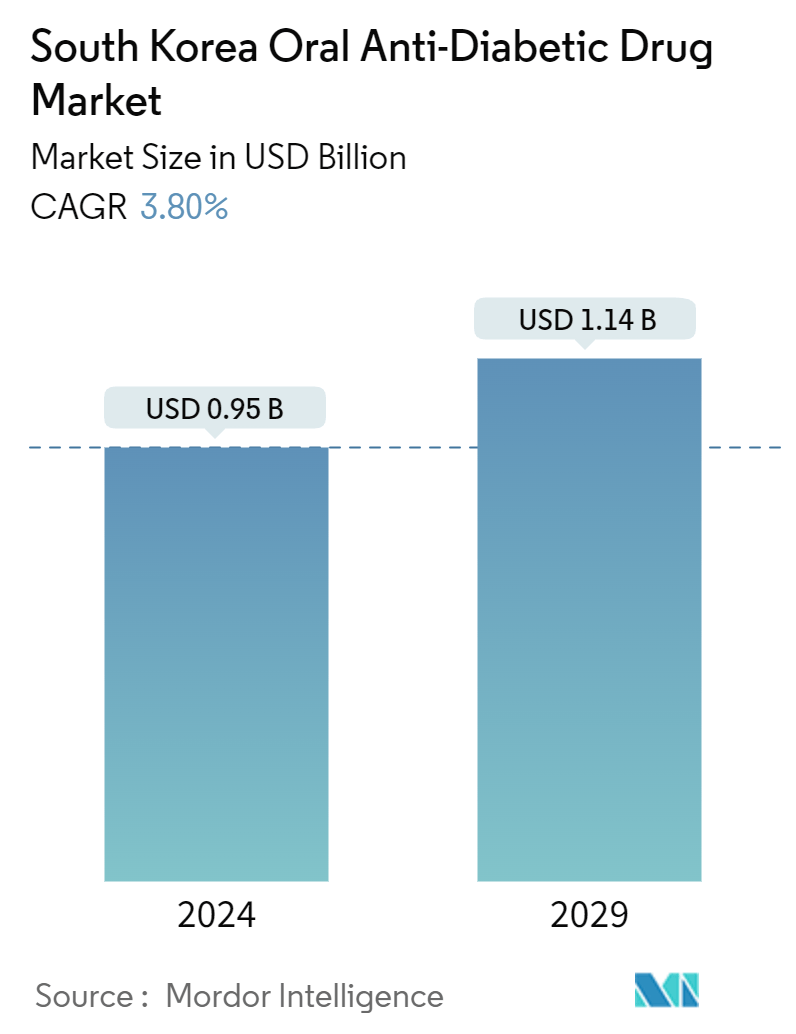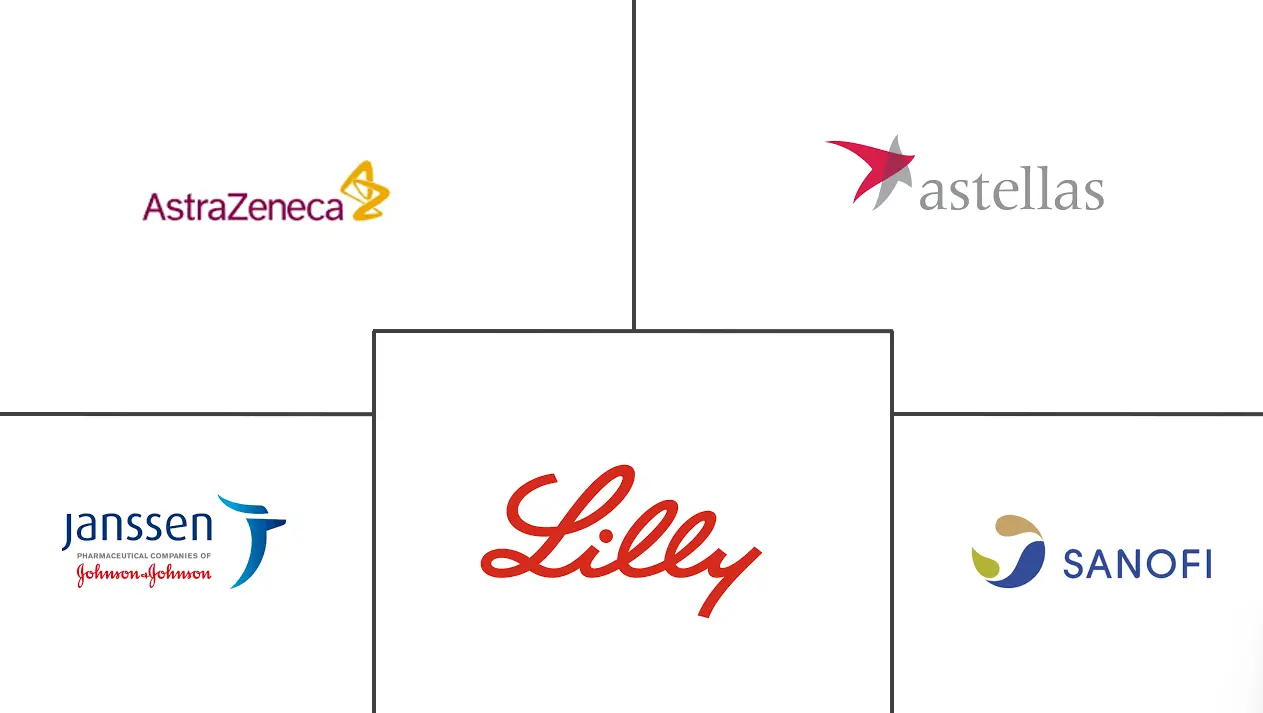Market Size of South Korea Oral Anti-Diabetic Drug Industry

| Study Period | 2019 - 2029 |
| Base Year For Estimation | 2023 |
| Forecast Data Period | 2024 - 2029 |
| Market Size (2024) | USD 0.95 Billion |
| Market Size (2029) | USD 1.14 Billion |
| CAGR (2024 - 2029) | 3.80 % |
| Market Concentration | High |
Major Players
*Disclaimer: Major Players sorted in no particular order |
South Korea Oral Anti-Diabetic Drug Market Analysis
The South Korea Oral Anti-Diabetic Drug Market size is estimated at USD 0.95 billion in 2024, and is expected to reach USD 1.14 billion by 2029, growing at a CAGR of 3.80% during the forecast period (2024-2029).
The South Korean market for oral anti-diabetes drugs is poised for growth during the forecast period. This growth can be attributed to a rising diabetes burden, bolstered by government initiatives and heightened awareness campaigns in South Korea. The increasing prevalence of diabetes has led to a greater demand for effective oral anti-diabetes medications. Government initiatives like public health programs and subsidies aim to improve diabetes management and treatment accessibility. Additionally, awareness activities, including educational campaigns and community outreach, enhance public knowledge about diabetes prevention and control.
For instance, according to the article published in the Korean Journal of International Medicine in January 2023, South Korea recorded approximately 3.7 million diabetes cases in 2022, marking a notable 22% surge from the previous year. This increase highlights a significant rise in the prevalence of diabetes over the four years. Notably, males accounted for 55.8% of the diabetic population in that year, indicating a higher incidence of diabetes among men compared to women. Thus, the high burden of diabetes in the country is expected to increase demand for oral anti-diabetes drugs during the forecast period.
Diabetes is more prevalent among adults in South Korea, and the economic cost of diabetes is more than that of general cancer. Diabetes problems or related comorbidities, as well as hospitalization, have considerable expenditures. Effective techniques are required to control diabetes complications, use healthcare resources, and decrease the financial burden. Increased knowledge of the scale and particular components of the economic burden of diabetes in Korea will likely persuade health officials to prioritize its prevention and management and commit more healthcare resources to diabetes.
The strategic activities of the market players, such as product launches, mergers, and acquisitions, are expected to contribute to market growth during the forecast period. For instance, in May 2022, Mounjaro (tirzepatide) injection to improve blood sugar control in adults with type 2 diabetes was approved as an addition to diet and exercise. Mounjaro was effective at improving blood sugar and was more effective than the other diabetes therapies with which it was compared in clinical studies.
Similarly, in June 2022, Daewoong Pharmaceutical confirmed promising phase 3 topline results focusing on the therapeutic effects of Enavogliflozin monotherapy and combination therapy with metformin. Daewoong's Enavogliflozin is an SGLT-2 inhibitor in development for the first time in Korea.
Therefore, owing to the above factors, the market is anticipated to grow during the forecast period.
South Korea Oral Anti-Diabetic Drug Industry Segmentation
Orally administered antihyperglycemic drugs reduce blood glucose levels. They are often used in type 2 diabetes care. The South Korean oral anti-diabetic drug market is segmented into drugs biguanides, alpha-glucosidase inhibitors, dopamine-D2 receptor agonists, sodium-glucose cotransport-2 (SGLT-2) inhibitors, dipeptidyl peptidase-4 (DPP-4) inhibitors, sulfonylureas, and meglitinides. The report offers the value (USD) and volume (units) for the above segments.
| Oral Anti-diabetic Drugs | ||||||
| ||||||
| ||||||
| ||||||
| ||||||
| ||||||
|
South Korea Oral Anti-Diabetic Drug Market Size Summary
The South Korean oral anti-diabetic drug market is set for significant growth over the forecast period, driven by an increasing diabetes burden and supportive government initiatives. The rising prevalence of diabetes in South Korea, particularly among adults, has led to a heightened demand for effective oral anti-diabetic medications. Government programs and subsidies aim to enhance diabetes management and treatment accessibility, while awareness campaigns are improving public knowledge about diabetes prevention and control. The economic impact of diabetes, which surpasses that of general cancer, underscores the need for effective management strategies to reduce healthcare costs and complications associated with the disease. This growing awareness and the strategic activities of market players, such as product launches and clinical trials, are expected to further propel market expansion.
The market is characterized by the presence of major global manufacturers like Eli Lilly, AstraZeneca, Sanofi, and Janssen Pharmaceuticals, alongside local players. These companies are focusing on innovations in diabetes drugs to capture a larger market share. The metformin segment is anticipated to lead the market, given its established role in managing type 2 diabetes. The South Korean healthcare system, under the National Health Insurance Act, supports the market by providing coverage for diabetes medications, which encourages their use. Recent strategic moves, such as Biocon Limited's licensing agreement with Handok and AstraZeneca's decision to cease distribution of certain products, highlight the dynamic nature of the market. Overall, the combination of increasing diabetes prevalence, government support, and strategic industry activities is expected to drive the market's growth during the forecast period.
South Korea Oral Anti-Diabetic Drug Market Size - Table of Contents
-
1. MARKET DYNAMICS
-
2. MARKET SEGMENTATION (Market Size by Value - USD)
South Korea Oral Anti-Diabetic Drug Market Size FAQs
How big is the South Korea Oral Anti-Diabetic Drug Market?
The South Korea Oral Anti-Diabetic Drug Market size is expected to reach USD 0.95 billion in 2024 and grow at a CAGR of 3.80% to reach USD 1.14 billion by 2029.
What is the current South Korea Oral Anti-Diabetic Drug Market size?
In 2024, the South Korea Oral Anti-Diabetic Drug Market size is expected to reach USD 0.95 billion.

